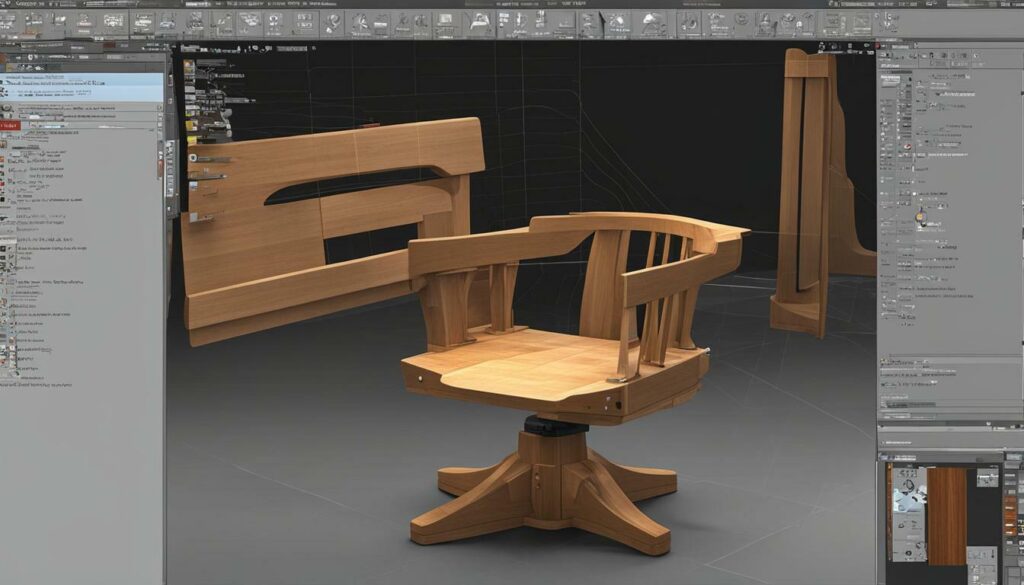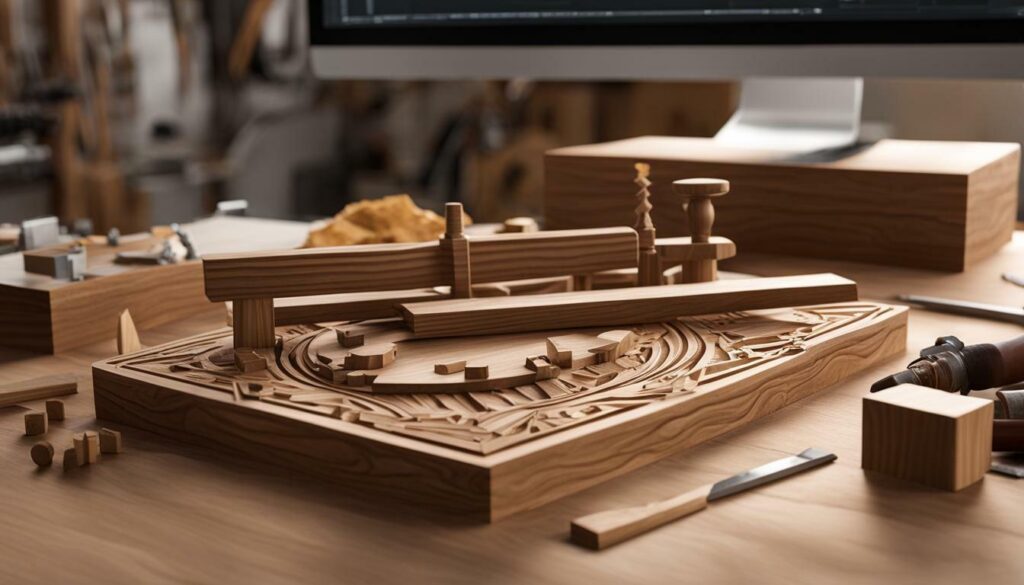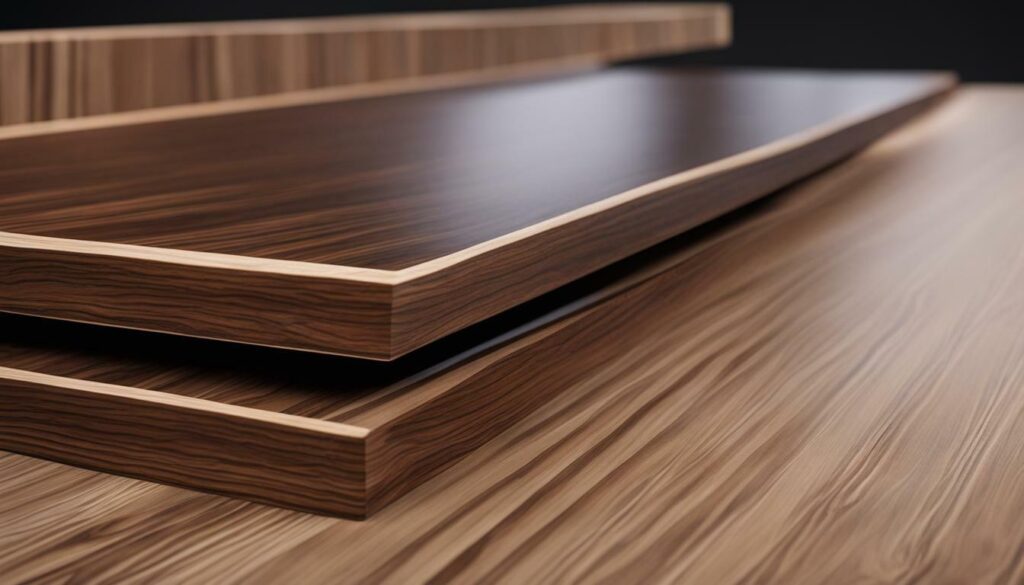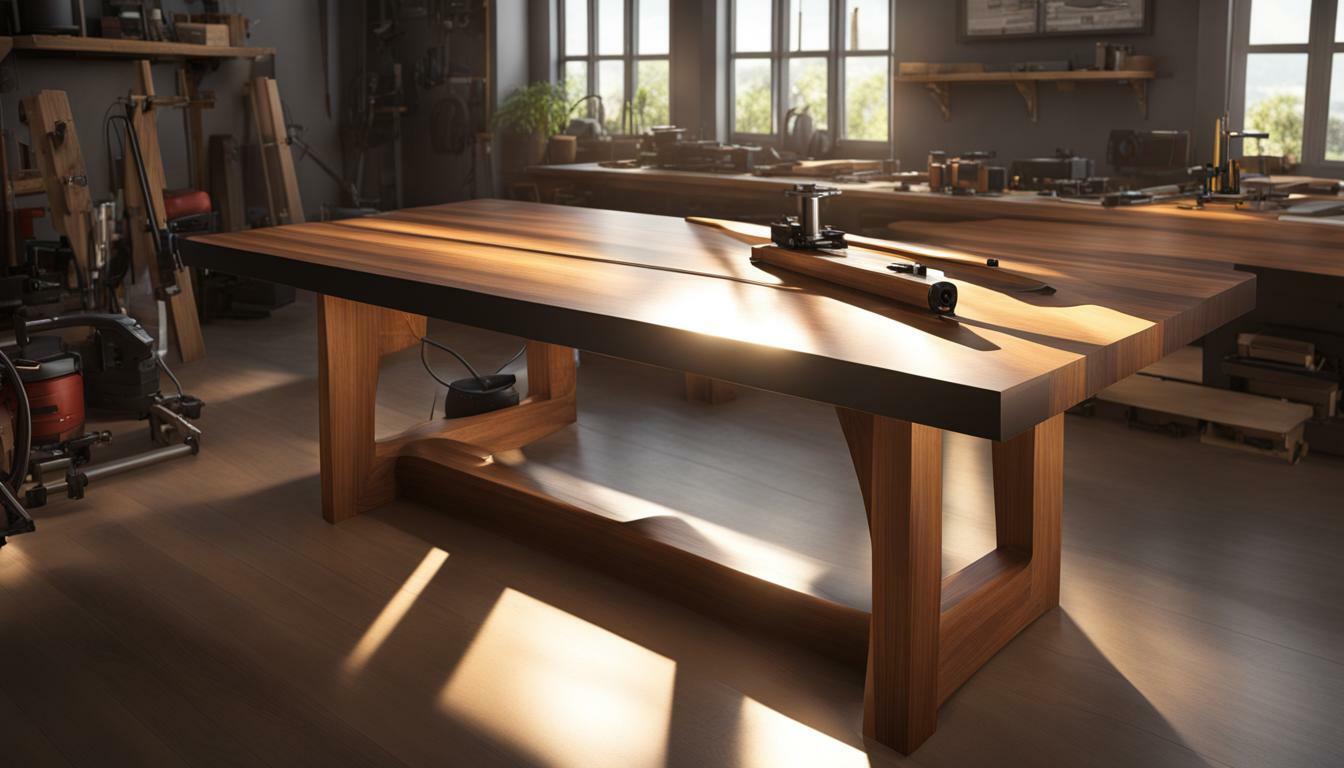SolidWorks, the renowned CAD software, may not be the first thing that comes to mind when you think of woodworking, but you’d be surprised by its potential in this craft. With the help of SWOOD, a software specifically created for woodworkers, SolidWorks opens up a whole new world of possibilities for woodworking projects.
- SolidWorks, when combined with SWOOD, offers dedicated woodworking features and tools integrated into the platform.
- SWOOD allows woodworkers to manage the entire woodworking project lifecycle, from design to production.
- It provides various capabilities such as material and panel processing, edge banding, grain direction, laminates, and more.
- SWOOD offers parametric capabilities for efficient design iterations and seamless integration with other SolidWorks solutions.
- With a fully integrated CAM system and nesting capabilities, SWOOD enables efficient production workflows for woodworking projects.
Understanding SolidWorks for Woodworking
SolidWorks, with its robust design capabilities, provides an excellent platform for woodworking enthusiasts to bring their ideas to life. Whether you are a professional woodworker or a hobbyist, SolidWorks offers a range of features and tools that can be utilized for designing woodworking projects with precision and ease.
With SolidWorks, you can create detailed 3D models of your woodworking designs, allowing you to visualize the final product before even starting the construction process. This helps you identify any potential issues or improvements, saving you time and materials in the long run.
One of the key advantages of using SolidWorks for woodworking is its integration with SWOOD, a software specifically created for woodworkers. SWOOD seamlessly integrates with SolidWorks, providing dedicated woodworking features and tools that enhance the design and production process.
SWOOD offers a wide range of capabilities for woodworking projects, including material and panel processing, edge banding, grain direction, and laminates. It also supports parametric capabilities, allowing you to easily modify and adapt your designs as needed. Furthermore, SWOOD integrates with other SolidWorks solutions such as PDM and Visualize, streamlining your workflow and ensuring seamless collaboration.
Table: SWOOD Features and Tools
| Features | Tools |
|---|---|
| Material and panel processing | Panel optimizer |
| Edge banding | Edge banding editor |
| Grain direction | Grain direction editor |
| Laminates | Laminate editor |
“SolidWorks, with its integration with SWOOD, provides woodworkers with a comprehensive platform to design and produce high-quality woodworking projects. The parametric capabilities and seamless integration with other SolidWorks solutions further enhance the woodworking workflow.”
In addition to its design features, SWOOD also offers a fully integrated CAM system with nesting capabilities. This allows you to generate production documents, including stocks list, hardware list, labels, and costing, streamlining your production workflow.
Overall, SolidWorks, in combination with SWOOD, provides woodworkers with a powerful and comprehensive toolset to create, visualize, and produce woodworking projects with precision and efficiency. Whether you are designing furniture, cabinetry, or custom woodwork, SolidWorks and SWOOD can help you bring your ideas to life.

Introducing SWOOD – Woodworking Software for SolidWorks
SWOOD, a dedicated woodworking software that integrates with SolidWorks, takes woodworking design to a whole new level. With SWOOD, woodworkers can harness the power of SolidWorks and enjoy a seamless workflow from design to production for their woodworking projects. Whether you are a professional carpenter or a hobbyist, SWOOD provides the necessary features and tools to bring your woodworking ideas to life.
One of the key advantages of SWOOD is its integration with SolidWorks, a leading 3D CAD software. This integration allows woodworkers to leverage the familiar SolidWorks interface while accessing dedicated woodworking functionality. SWOOD adds woodworking-specific features and tools to the SolidWorks platform, making it a comprehensive solution for woodworking design.
With SWOOD, woodworkers can easily manage all aspects of their woodworking projects. From material and panel processing to edge banding, grain direction, and laminates, SWOOD offers a wide range of capabilities to enhance woodworking design. It enables precise modeling and visualization of woodworking plans, ensuring accuracy and efficiency in the production process.
Furthermore, SWOOD’s parametric capabilities allow woodworkers to make quick and easy modifications to their designs. This flexibility enables them to adapt their projects as needed, accommodating changes and customer preferences effortlessly. Additionally, SWOOD seamlessly integrates with other SolidWorks solutions such as PDM (Product Data Management) and Visualize, providing a streamlined workflow and enhancing collaboration.

| Feature | Description |
|---|---|
| Material and Panel Processing | SWOOD offers advanced tools for material selection, panel optimization, and nesting, ensuring efficient use of resources and minimal waste. |
| Edge Banding, Grain Direction, and Laminates | Woodworkers can easily apply edge banding, define grain direction, and add laminates to their designs, enhancing the overall aesthetics and functionality of their projects. |
| Parametric Design | SWOOD’s parametric capabilities allow for easy modification of woodworking designs, offering flexibility and adaptability throughout the project lifecycle. |
| Integration with Other SolidWorks Solutions | SWOOD seamlessly integrates with other SolidWorks solutions such as PDM and Visualize, enhancing collaboration, data management, and visualization capabilities. |
| Fully Integrated CAM System | SWOOD’s integrated CAM system enables woodworkers to generate toolpaths and G-code, streamlining the production process and ensuring precise machining. |
| Nesting Capabilities | SWOOD’s nesting capabilities allow for optimal material usage by automatically arranging parts on sheets, reducing waste and improving efficiency. |
SWOOD Features and Tools
SWOOD provides a range of specialized woodworking features and tools within the SolidWorks environment, making it a powerful tool for creating detailed woodworking plans. With SWOOD, you can easily design and visualize woodworking projects, from cabinets and furniture to intricate joinery.
One of the notable features of SWOOD is its material and panel processing capabilities. You can define custom materials, manage grain direction, and even apply edge banding and laminates, all within the SolidWorks interface. This allows you to accurately represent the materials and finishes in your woodworking designs.
Moreover, SWOOD offers parametric capabilities, allowing you to easily modify and update your woodworking plans as needed. This flexibility is particularly useful when it comes to managing complex joinery and intricate details that may require frequent adjustments.
SWOOD CAM System and Nesting Capabilities
SWOOD also integrates a fully-featured CAM system that supports various CNC brands. This enables you to generate production documents, such as stocks lists, hardware lists, labels, and costing, directly from your SolidWorks models. The nesting capabilities of SWOOD optimize material usage, reducing waste and increasing overall efficiency in your woodworking production workflows.
With SWOOD, you have a comprehensive solution that seamlessly integrates woodworking functionalities into the SolidWorks environment. Whether you are a professional woodworker or a hobbyist, SWOOD empowers you to bring your woodworking projects to life with precision and efficiency.

| Feature | Description |
|---|---|
| Material and Panel Processing | Manage custom materials, grain direction, and apply edge banding and laminates. |
| Parametric Capabilities | Easily modify and update woodworking plans and designs. |
| CAM System and Nesting | Generate production documents and optimize material usage with nesting capabilities. |
SWOOD provides a comprehensive set of woodworking features and tools within the SolidWorks environment, offering woodworkers the ability to design, visualize, and produce high-quality woodworking projects. Its seamless integration and parametric capabilities make it an ideal tool for creating detailed woodworking plans. The material and panel processing features, along with the edge banding, grain direction, and laminate capabilities, allow for precise representation of materials and finishes. The SWOOD CAM system and nesting capabilities further enhance the production workflow by generating optimized production documents and reducing material waste. With SWOOD, woodworkers can unleash their creativity and bring their woodworking projects to life with efficiency and precision.
Seamless Integration and Parametric Capabilities
SWOOD seamlessly integrates with SolidWorks, allowing woodworkers to easily modify and adapt their designs as per their requirements. With its intuitive interface and powerful parametric capabilities, SWOOD empowers woodworkers to create and customize woodworking projects with ease.
One of the key advantages of using SWOOD is its seamless integration with SolidWorks. Woodworkers can leverage the familiar SolidWorks environment to design their projects while utilizing SWOOD’s dedicated woodworking features and tools. This integration eliminates the need to switch between different software, streamlining the design process and increasing productivity.
SWOOD’s parametric capabilities further enhance flexibility and efficiency in woodworking projects. Woodworkers can easily make modifications to their designs, such as changing dimensions, materials, or assembly configurations, with just a few clicks. This allows for quick adjustments and iterations, saving valuable time and effort in the design phase.

Furthermore, SWOOD offers a wide range of parametric libraries, including profiles, joints, and assembly features specific to woodworking. These libraries provide woodworkers with a comprehensive collection of pre-defined elements that can be easily incorporated into their designs. This helps in speeding up the design process and ensures accurate representations of woodworking components.
In summary, SWOOD’s seamless integration with SolidWorks and its robust parametric capabilities make it an ideal software solution for woodworkers. It enables them to efficiently design, modify, and adapt woodworking projects according to their needs, all within the familiar SolidWorks environment.
Table 1: SWOOD Features and Tools
| Feature/Tool | Description |
|---|---|
| Material and Panel Processing | Efficiently manage cutting lists, optimize material usage, and generate detailed reports for materials and panels. |
| Edge Banding, Grain Direction, and Laminates | Customize edge banding profiles, specify grain direction, and apply laminates to enhance the aesthetics of woodworking projects. |
| Integration with Other SolidWorks Solutions | Integrate seamlessly with other SolidWorks solutions, such as PDM and Visualize, for a streamlined woodworking workflow. |
| SWOOD CAM System and Nesting Capabilities | Utilize the integrated CAM system to generate toolpaths for CNC machines and optimize nesting for efficient production workflows. |
Material and Panel Processing
SWOOD provides woodworkers with comprehensive tools for managing material and panel processing, ensuring precision and efficiency in their woodworking projects. With SWOOD, you can easily define your materials, select the appropriate grain direction, and optimize your cutting plans to minimize waste and maximize productivity.
One of the standout features of SWOOD is its ability to create parametric libraries of materials, ensuring accuracy and consistency throughout your designs. Whether you’re working with different types of wood, laminates, or other materials, SWOOD allows you to define their properties and apply them seamlessly to your project. This means that you can easily switch between materials or update their dimensions without having to redraw or modify your entire design.
When it comes to panel processing, SWOOD offers a range of powerful tools to streamline your workflow. It allows you to create nested optimization plans, automatically arranging your parts on the panels to minimize material waste. SWOOD also provides intuitive labeling functionalities, making it easy to identify and locate each component during the assembly process.

With SWOOD’s material and panel processing capabilities, you can confidently tackle any woodworking project with efficiency and precision. Whether you’re designing intricate furniture pieces or crafting custom cabinets, SWOOD’s integrated tools and features within SolidWorks will elevate your woodworking experience to a whole new level.
| Key Features of SWOOD for Material and Panel Processing: |
|---|
| Parametric libraries for defining and managing different materials |
| Grain direction control for realistic visualization |
| Nested optimization plans to minimize material waste |
| Labeling functionalities for easy component identification and location |
Testimonial:
“SWOOD has revolutionized the way I approach material and panel processing in my woodworking projects. With its intuitive interface and comprehensive tools, I can now optimize my designs and minimize waste without compromising on quality. It’s truly a game-changer!” – John, Professional Woodworker
Edge Banding, Grain Direction, and Laminates
SWOOD empowers woodworkers with the ability to incorporate precise edge banding, grain direction, and laminates into their designs, resulting in stunning finished products. With SWOOD’s dedicated woodworking features and tools integrated into the SolidWorks platform, you can create intricate designs that showcase your craftsmanship.
When it comes to edge banding, SWOOD offers a range of options to add a professional touch to your projects. Whether you prefer traditional veneer banding or modern PVC banding, SWOOD provides the tools to seamlessly apply and adjust the edges, ensuring a clean and polished look.
Grain direction plays a crucial role in woodworking, as it determines the overall appearance and structural integrity of the final piece. SWOOD simplifies this process by allowing you to visualize and manipulate the grain direction within your design. With just a few clicks, you can align the grain perfectly, enhancing the natural beauty of the wood.
In addition to edge banding and grain direction, SWOOD also offers a wide range of laminate options. From high-pressure laminates to decorative foils, you can experiment with different finishes and textures to achieve the desired aesthetic. With SWOOD’s extensive library of laminates, you can easily apply and customize the laminates to match your design vision.
| SWOOD Woodworking Features | |
|---|---|
| Precise edge banding |  |
| Grain direction control |  |
| Assortment of laminates |  |
By utilizing SWOOD’s edge banding, grain direction, and laminate features, you can bring your woodworking designs to life, showcasing the beauty and precision that sets your work apart. Whether you’re creating custom furniture, cabinets, or intricate woodwork, SWOOD provides the necessary tools to elevate your woodworking designs and achieve exceptional results.
Integration with Other SolidWorks Solutions
SWOOD seamlessly integrates with other SolidWorks solutions like PDM and Visualize, providing woodworkers with a comprehensive toolbox for their projects. With the integration of SWOOD and PDM, woodworkers can easily manage their designs, collaborate with team members, and ensure version control and data management throughout the woodworking process. Visualize, on the other hand, enhances the visualization and rendering capabilities, allowing woodworkers to create stunning 3D visualizations of their woodworking projects.
Enhanced Collaboration with PDM
The integration of SWOOD and PDM streamlines the collaboration process for woodworkers. PDM, short for Product Data Management, enables woodworkers to easily manage and control their design data within SolidWorks. It provides a centralized database where team members can access, modify, and share woodworking project files. With PDM, woodworkers can effectively collaborate on designs, ensuring everyone is working on the latest version of the project. This integration boosts efficiency, reduces errors, and helps maintain the integrity of woodworking projects from start to finish.
Dazzling Visualizations with Visualize
Visualize enhances the visualization capabilities within SolidWorks, allowing woodworkers to create photorealistic renderings of their woodworking projects. With Visualize, woodworkers can add textures, lighting effects, and realistic materials to their designs, giving clients and stakeholders a clear and vivid representation of the final product. This helps in making informed decisions, attracting potential customers, and showcasing the craftsmanship of the woodworking projects. Visualize is a powerful tool that adds that extra wow factor to woodworking designs.
| SolidWorks Integration | Benefits |
|---|---|
| PDM | Efficient data management and collaboration |
| Visualize | Superior visualization and stunning 3D renderings |
With the integration of SWOOD, PDM, and Visualize, woodworkers have access to a complete set of tools that streamline the woodworking process from start to finish. From design and data management to visualization and rendering, these solutions work in harmony to enhance productivity, accuracy, and efficiency in woodworking projects.

SWOOD’s fully integrated CAM system, along with its nesting capabilities, streamlines the production process for woodworking projects, reducing waste and maximizing efficiency. With SWOOD, you can optimize the use of your raw materials by automatically nesting parts on panels, minimizing material waste. Whether you’re cutting intricate joinery or creating complex shapes, SWOOD’s CAM system ensures accurate and precise results every time.
By utilizing SWOOD’s nest features, you can arrange your parts on the panel in the most efficient way, taking into consideration grain direction, material size, and required machining operations. This not only saves time but also reduces material costs.
SWOOD’s nesting capabilities are further enhanced by its ability to generate production documents. These documents include stocks lists, hardware lists, labels, and costing data, providing you with all the necessary information for a successful woodworking project. With SWOOD, you can easily stay organized and keep track of your materials and hardware, ensuring a smooth and seamless production process from start to finish.
SWOOD CAM System and Nesting Capabilities: An Example
Let’s say you’re working on a custom cabinet project. With SWOOD, you can easily design your cabinet and generate the necessary production documents. Once you’re ready to manufacture, SWOOD’s CAM system comes into play.
Using the nesting capabilities, SWOOD will automatically arrange and optimize the placement of your cabinet parts on the panel, taking into account the grain direction and minimizing waste. This means you can maximize the use of your raw materials and reduce the need for additional panels, ultimately saving you money.
Furthermore, SWOOD’s production documents provide you with all the information you need to complete the project efficiently. The stocks list ensures you have the necessary materials on hand, the hardware list ensures you have the required fittings, and the labels help you identify each part during assembly. With SWOOD’s CAM system and nesting capabilities, your custom cabinet project becomes a streamlined and cost-effective endeavor.
| Benefits of SWOOD’s CAM System and Nesting Capabilities |
|---|
| Reduces material waste |
| Saves time and money |
| Ensures accurate and precise results |
| Optimizes use of raw materials |
| Generates production documents for easy organization |
With SWOOD’s fully integrated CAM system and nesting capabilities, woodworking projects become more efficient, cost-effective, and environmentally friendly. From fine furniture to custom cabinetry, SWOOD empowers woodworkers to bring their designs to life with precision and ease.

SolidWorks, when combined with SWOOD, unlocks a world of possibilities for woodworkers, enabling them to create intricate designs and streamline their woodworking projects. With SWOOD, woodworkers can seamlessly integrate woodworking features and tools into the SolidWorks platform, providing a comprehensive solution for designing and producing woodworking projects.
SWOOD offers a range of capabilities that cater specifically to the needs of woodworkers. From material and panel processing to edge banding, grain direction, and laminates, SWOOD provides a robust set of features that enhance woodworking design and allow for greater precision and customization.
Furthermore, SWOOD’s parametric capabilities empower woodworkers to easily modify and adapt their designs, ensuring flexibility throughout the woodworking process. The integration of SWOOD with other SolidWorks solutions, such as PDM and Visualize, further enhances the workflow, simplifying project management and visualization.
SWOOD also includes a fully integrated CAM system with nesting capabilities, streamlining the production workflow and optimizing material usage. With support for various CNC brands and the ability to generate production documents, including stocks list, hardware list, labels, and costing, SWOOD simplifies the production process and ensures efficient and accurate manufacturing.
In conclusion, SolidWorks, in conjunction with SWOOD, offers woodworkers a powerful and comprehensive tool for their woodworking projects. From design to production, SWOOD provides the necessary features and tools to create stunning and precise woodworking designs. Whether you’re a professional woodworker or a hobbyist, SolidWorks combined with SWOOD is a game-changer for woodworking enthusiasts.
FAQ
Q: Can I use SolidWorks for woodworking?
A: Absolutely! SolidWorks can be utilized for woodworking projects with the help of SWOOD, a software specifically designed for woodworkers. SWOOD provides dedicated woodworking features and tools that are integrated into the SolidWorks platform.
Q: What is SWOOD?
A: SWOOD is a woodworking software created to seamlessly integrate with SolidWorks. It enhances the capabilities of SolidWorks for woodworkers, allowing them to manage woodworking projects from design to production.
Q: What features does SWOOD offer for woodworking?
A: SWOOD offers a range of features and tools that are essential for woodworking projects, including material and panel processing, edge banding, grain direction, and laminates. It also provides parametric capabilities and integration with other SolidWorks solutions such as PDM and Visualize.
Q: How does SWOOD enhance the woodworking workflow?
A: SWOOD provides seamless integration with SolidWorks, allowing woodworkers to design and manage their woodworking projects efficiently. It offers a fully integrated CAM system with nesting capabilities, supports various CNC brands, and provides production documents like stocks list, hardware list, labels, and costing.
Q: Can SWOOD be used for production planning?
A: Yes, SWOOD offers production planning capabilities by providing production documents such as stocks list, hardware list, labels, and costing. It ensures smooth and organized production workflows for woodworking projects.
Q: Is SWOOD suitable for both small-scale and large-scale woodworking projects?
A: Absolutely! SWOOD is designed to cater to both small-scale and large-scale woodworking projects. Its features and tools are scalable, ensuring that woodworkers can utilize it for projects of various sizes and complexities.
Q: Does SWOOD support various CNC brands?
A: Yes, SWOOD supports various CNC brands, allowing woodworkers to seamlessly integrate their preferred CNC machines with SolidWorks and SWOOD. This ensures compatibility and flexibility in the woodworking production process.
How Can Woodworking Skills Benefit My SolidWorks Projects?
Having a foundation in woodworking skills can greatly benefit your SolidWorks projects. The ability to understand how wood pieces fit together and the techniques used for shaping and joining can contribute to your design approach. By incorporating learn woodworking skills into your SolidWorks projects, you can achieve more realistic and functional designs.

